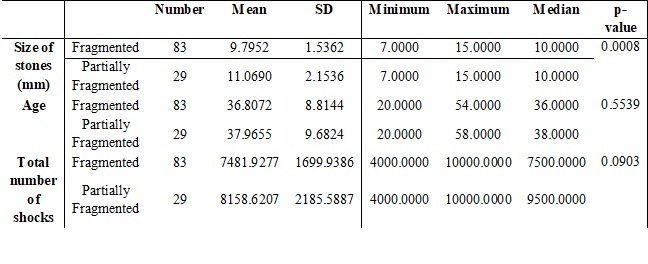Extra corporeal shock wave lithotripsy in renal and ureteric stones: an institutional experience
Abstract
Introduction:Urolithiasis is one of the most common clinical conditions in the history of medicine. Treatment methods include conservative, surgical treatment and extracorporeal shock wave lithotripsy (ESWL). Several stone characteristics are known to affect outcome of ESWL such as fragility, Hounsfield unit, size, site, composition etc. No study has been done till now regarding the efficacy and safety of ESWL in eastern Indian patients.
Objectives: To assess the efficacy and safety of ESWL in the management of patients with renal and ureteral stones.
Methods: 112 outpatients were treated with ESWL. Stone size, location, total number of shockwaves, stone-free rate, complications and adjunctive interventions were investigated. Chi-Square and Logistic Regression analyses were used, with p<0.05 set as the level of significance.
Result & Conclusion: The authors found significant association between the size and number of stones with fragmentation status. The authors found that stones of more than 11mm size are more resistant to ESWL. Authors found statistically significant association between the number of ESWL sessions with fragmentation status. However, more than 3 sessions also did not help much. It was also found that complications were more in partially fragmented group and more adjunctive procedures were required in partially fragmented group. The authors also noticed that the stented or non stented status and total number of shocks were not significantly associated with the fragmentation status of stones.
Downloads
References
Prstojevic JK, Junuzovic D, Hasanbegovic M, et al. Characteristics of calculi in the urinary tract. Mater Sociomed. 2014 Oct;26(5):297-302. doi: https://dx.doi.org/10.5455%2Fmsm.2014.26.297-302. Epub 2014 Oct 29.
Marshall LS, Tanagho EA, McAninch JW. Urinary Stone Disease. In: Tanagho EA, editor. Smith's General Urology. 16th edition. San Francisko: Lange Medical Book; 2004.
Mennon M, Resnick M, Retik AB, et al. Urinary Lithiasis: Etiology, Diagnosis and Medical Management. In: Walsh PC, Retik AB, Vaughan ED, Wein AJ, et al., editors. Campbell’s Urology. 8ht ed. Philadelphia, PA: Saunders Elsevier; 2002. pp. 3287–3289.
Grasso M, Beaghler M, Loisides P. The case for primary endoscopic management of upper urinary tract calculi: II. Cost and outcome assessment of 112 primary ureteral calculi. Urology. 1995; 45:372–376.
Chaussy C, Brendel W, Schmiedt E. Extracorporeally induced destruction of kidney stones by shock waves. Lancet. 1980 Dec 13;2(8207):1265-8.
Hassouna ME, Oraby S, Sameh W, et al. Clinical experience with shock-wave lithotripsy using the Siemens Modularis Vario lithotripter. Arab J Urol. 2011 Jun;9(2):101-5. doi: https://doi.org/10.1016/j.aju.2011.06.004. Epub 2011 Sep 9.
Nomikos MS, Sowter SJ, Tolley DA. Outcomes using a fourth-generation lithotripter: a new benchmark for comparison? BJU Int. 2007 Dec;100(6):1356-60. Epub 2007 Sep 11.
Bon D, Dore B, Irani J, et al. Radiographic prognostic criteria for extracorporeal shock-wave lithotripsy: a study of 485 patients. Urology. 1996 Oct;48(4):556-60; discussion 560-1.
Augustin H. Prediction of stone-free rate after ESWL. Eur Urol. 2007 Aug;52(2):318-20. Epub 2007 Mar 26.
Jamshaid A, Ather MH, Hussain G, Khawaja KB. Single center, single operator comparative study of the effectiveness of electrohydraulic and electromagnetic lithotripters in the management of 10- to 20-mm single upper urinary tract calculi. Urology 2008; 72:991-995.
Lalak NJ, Moussa SA, Smith G, et al. The Dornier Compact Delta lithotripter: the first 150 ureteral calculi. J Endourol. 2002 Nov;16(9):645-8. DOI: https://doi.org/10.1089/089277902761402970.
Georgiev MI, Ormanov DI, Vassilev VD, Dimitrov PD, Mladenov VD, Popov EP, et al. Efficacy of tamsulosin oral controlled absorption system after extracorporeal shock wave lithotripsy to treat urolithiasis. Urology 2011; 78:1023-1026.
Goren MR. Buoctmiploh. Can we predict the success of shockwave lithotripsy by stone density measured with computerised tomography. Eur Urol Suppl 2006; 5:186.
Sanjeev Pathaka. Radiological determination of stone density and skin-to-stone distance-Can it predict the success of extracorporeal shock wave lithotripsy? Br J Med Surg Urol 2009; 2:180-184.
European Association of urology. [Home page of European Association of Urology] [Online]. [Cited December 2011] Available from URL: http://www.uroweb.org/2011.11-12-2011.
Mohayuddin N, Malik HA, Hussain M, et al. The outcome of extracorporeal shockwave lithotripsy for renal pelvic stone with and without JJ stent--a comparative study. J Pak Med Assoc. 2009 Mar;59(3):143-6.
Inoue H, Kamphausen T, Bajanowski T, et al. Massive retroperitoneal haemorrhage after extracorporeal shock wave lithotripsy (ESWL). Int J Legal Med. 2011 Jan;125(1):75-9. doi: https://doi.org/10.1007/s00414-010-0489-6. Epub 2010 Jul 11.
Maker V, Layke J. Gastrointestinal injury secondary to extracorporeal shock wave lithotripsy: a review of the literature since its inception. J Am Coll Surg 2004; 198:128-135.
Krambeck AE, Rule AD, Li X, Bergstralh EJ, Gettman MT, Lieske JC. Shock wave lithotripsy is not predictive of hypertension among community stone formers at long-term followup. J Urol 2011; 185:164-169.
Al-Marhoon, M., Shareef, O., Al-Habsi, I., Al Balushi, A., Mathew, J. and Venkiteswaran, K. Extracorporeal Shock-wave Lithotripsy Success Rate and Complications: Initial Experience at Sultan Qaboos University Hospital. Oman Medical Journal 2013; 28:255-259.



 OAI - Open Archives Initiative
OAI - Open Archives Initiative


